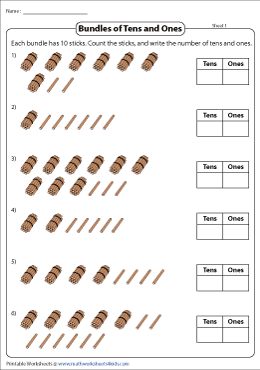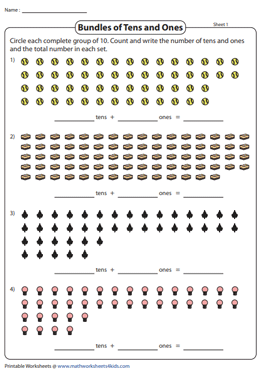- Worksheets>
- Math>
- Number Sense>
- Place Value>
- Bundles of Tens and Ones
Bundles of Tens and Ones Worksheets
Pique the interest of your eager-to-learn kids with our printable bundles of tens and ones worksheets featuring adequate exercises in grouping and splitting numbers into tens and ones. Kids in kindergarten, grade 1, and grade 2 get acquainted with the fact that the two digits of a two-digit number represent amounts of tens and ones and a group of 10 tens makes a 100. Deliberate practice in place values being the motto of these pdfs, the exercises reiterate these simple facts, and help kids comprehend that the position of each digit in a number is significant. Our answer key feature accelerates evaluation. Begin your practice with our free bundles of tens and ones worksheets.
Composing and Decomposing | Tens and Ones
The numbers from 11 to 19 are composed of a ten and few ones. Kids in kindergarten count the individual units and form the numeral in Part A and group objects into bundles of ten, and decompose them into tens and ones in Part B.
Counting Bundles of Sticks | No Regrouping
Buff up the place value skills of your 1st grade kid with our printable bundles of tens and ones worksheets. Count each bundle made up of 10 sticks and the individual sticks separately and write the numeral.
Bundling Shapes into Tens | Regrouping Ones
Push boundaries with our bundling shapes into tens worksheet pdfs that involve regrouping. Kids count and fuse the ones and check if they can make a ten, and trade the extra ones for tens and write the total.
Grouping Real-life Objects into Tens and Ones
Cracking these bundles of tens and ones worksheets is a true measure of your place value skills. Bundle real-life objects into groups of tens by circling them. Count the 10s and the leftover 1s, and write the number.
Bundles of Tens and Ones (10 tens + ones) | 3-digit
Get 2nd grade kids out of their comfort zones as they understand that 100 refers to a bundle of 10 tens. Let them count the bundles of hundred, tens and the individual units, and form the 3-digit number.





